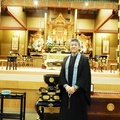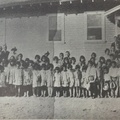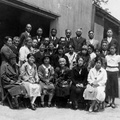In the Japanese community of Southern California, which has a history of 120 years, the Jodo Shinshu Nishi Honganji Buddhist Church played a role as a cultural and community center for Japanese immigrants more than just a religious institution, especially for about 60 years in the first half of the 20th century.
The American Buddhist Association, the Nishi Honganji sect's American organization, has called places where believers gather "Buddhist churches" rather than "temples" since before the war. Recently, more and more people are calling them "tera." The monks who belong to local Buddhist associations are called missionaries. In Japan, the chief priest is generally a hereditary system in most Buddhist sects, including Jodo Shinshu, but in the case of the American Buddhist Association, members of the Buddhist association are the owners of the temples, and local Buddhist associations request and invite missionaries from the Buddhist Association. The management of Buddhist churches is modeled on that of Christian churches.
The American Buddhist Community has a history of more than 100 years of missionary work, and until the 1980s, most of its missionaries were Japanese who were born and raised in Japan and came to the U.S. But since then, the number of Americans, including those of Japanese descent, who have become missionaries has been increasing. Currently, the American Buddhist Community has a course to train missionaries, and recently, more and more people are becoming monks in the U.S. without going to Japan to train.
In March 2017, at the Gardena Buddhist Church near Los Angeles, which was founded more than 90 years ago ( see article published on February 27, 2017 ), the Japanese-born chief evangelist, Reverend Miyaji Nobuo, retired and Los Angeles-born third-generation Japanese-American, Reverend Iohara Kazunori (55 years old at the time), took over as chief evangelist.
Reverend Ihara was born to a Hiroshima-born Issei mother and Los Angeles-born Nisei father. From a young age, he was taken by his parents to the Nishi Honganji Los Angeles Betsuin temple in Little Tokyo. He says he had been thinking about becoming a Buddhist monk ever since.
He majored in psychology at the University of California, Los Angeles (UCLA) hoping that it would help him prepare for the priesthood. UCLA had an exchange program with the International Christian University in Tokyo, so Reverend Ihara used this program to stay in Tokyo for a year in 1983, during which time he prepared to be ordained at the Tsukiji Honganji Temple in Tokyo.
After graduating from UCLA, Reverend Ihara obtained a master's degree in psychology from a private university in Toronto, Canada. In 1986, he received a scholarship from the Nishi Honganji sect's North American Missionary District to train missionaries and studied at Ryukoku University in Kyoto. He spent the first year taking intensive Japanese language classes and then completed a two-year master's course. He was then accepted as a government-sponsored student by the Ministry of Education, Culture, Sports, Science and Technology and spent four years in the doctoral program at Ryukoku University. Under the guidance of Professor Noriyoshi Asano, an authority on Shinran studies, the theme of both his master's and doctoral studies was "A Study of Faith in Saint Shinran," and in particular, in his doctoral studies, he worked on "Saiho Shinan Sho," written by Saint Shinran in his later years.
Rev. Ihara's work as a missionary for the American Buddhist Community began in 1994 when he was dispatched to Fresno Betsuin. He was subsequently dispatched to Vista Buddhist Church near San Diego, Seattle Betsuin, Venice Hongwanji in the Los Angeles area, and has served as a missionary for Gardena Buddhist Church since 2014.
Gardena Buddhist Church is a large Buddhist church with about 500 members (200 households), and two missionaries are dispatched at any one time. When Rev. Miyaji retired in March 2017 and Rev. Ihara became the chief missionary, Rev. Sara Sekiya (female) was transferred from Seattle Betsuin as the second missionary. Sekiya is from Setagaya, Tokyo, spent her high school years in the San Francisco Bay Area and Manhattan, New York, and graduated from Boston University. After working in Tokyo for 12 years, she joined the Central Buddhist Institute in Kyoto in 2012 and was dispatched to Seattle Betsuin as a missionary in September 2015.
The main hall of Gardena Buddhist Church has a shining gold sanctuary. Dressed as a regular monk with a robe and a Buddhist monk's robe, Reverend Ihara walks freely around the majestic sanctuary while preaching, wearing a microphone headset that singers use on stage. He then reads from the Gobunsho (literal writings) of Rennyo Shonin, an important sutra of the Jodo Shinshu sect. The intonation of his voice conveys a sense of dignity reminiscent of the 15th century Japanese that Rennyo Shonin would have spoken.
© 2018 Shigeharu Higashi





